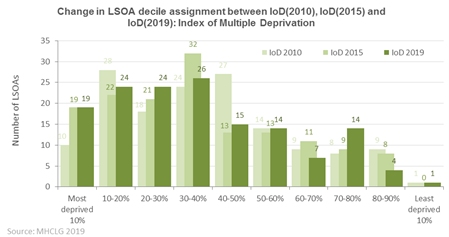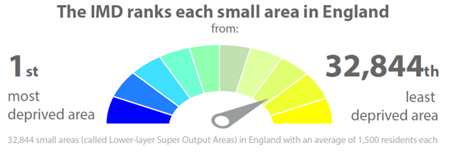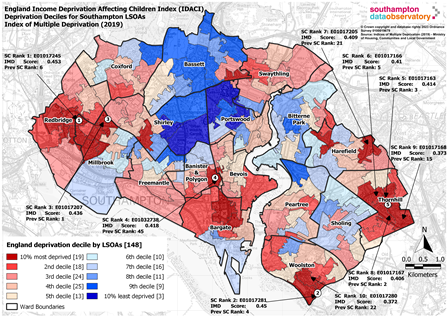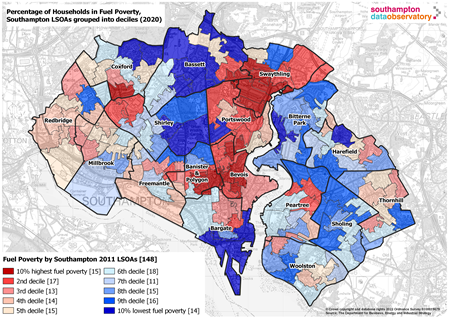
Deprivation and poverty
 Deprivation and poverty in Southampton
Deprivation and poverty in Southampton
Economic growth in Southampton was relatively healthy up until the pandemic, with Southampton achieving significant economic growth up until this point, in line with the affluent South. However, the city’s characteristics relating to poverty and deprivation continue to present challenges more in common with other urban areas across the country with high levels of deprivation.
The Index of Multiple Deprivation (IMD 2019) illustrates how Southampton continues to be a relatively deprived city. Based on average deprivation rank of its neighbourhoods (LSOAs), Southampton is now ranked 55th (where 1 is the most deprived) out of 317 local authorities: more deprived than the comparator cities of Bristol (82nd), Leeds (92nd) and Sheffield (93rd). Southampton has 19 LSOAs within the 10% most deprived in England and one in the 10% least deprived. More information on the Indices of Multiple Deprivation can be found below.
 The 2008 economic recession and welfare reforms including the introduction of Universal Credit had a marked impact on Southampton and its residents. In practice, the direct impact of the welfare reforms is not shared equally; they impact hardest on some of our most deprived households, with some households affected by several changes.
The 2008 economic recession and welfare reforms including the introduction of Universal Credit had a marked impact on Southampton and its residents. In practice, the direct impact of the welfare reforms is not shared equally; they impact hardest on some of our most deprived households, with some households affected by several changes.
The coronavirus pandemic, unprecedented levels of inflation and the ‘cost of living crisis’ have the capacity to exacerbate existing levels of poverty and deprivation in Southampton, whilst bringing about new challenges. More information is available on the Cost of Living pages.
Claimant count data is published monthly and allows for the proportion of adults claiming out of work benefits to be monitored in detail. Locally and nationally the number of adults claiming out of work benefits has increased over the last year. As of December 2024, 4.4% (7,470) of the working age population were claiming out of work benefits in Southampton; an increase of +540 claimants (+7.8%) since December 2023 (4.1%). Whilst progress was made in recovering from the COVID-19 pandemic, Southampton is yet to return to the pre-pandemic baseline (less than 3.5% in January to March 2020). This could possibly be linked to recent financial pressures and economic uncertainty, with the number of claimants gradually increasing over the last year.
In 2023, the median weekly gross earnings for a full-time employee, resident in Southampton was estimated to be £652, which is below the England average of £683. In addition, those working in the city earn more than those resident in city (£52 per week gap for full time workers), suggesting the best paid jobs in Southampton are being undertaken by workers commuting into the city. More information on wages, employment and Southampton’s economy can be found in the Southampton Economic Assessment.
Deprivation and inequalities between residents and neighbourhoods in Southampton are significant and continue to be a driver for crime and poor health outcomes in Southampton. In addition, key outcomes for children and young people in Southampton continue to be poorer than the national average, with outcomes significantly poorer (and starting earlier in life) for those residents living in the most deprived areas of the city compared to those living in the least deprived areas. More information on the variation in outcomes for Southampton residents can be found on the inequality profiles and health inequalities pages.
Index of Multiple Deprivation (IMD)
The Department for Levelling Up, Housing & Communities (DLUHC) published the latest Indices of Deprivation (IoD) in 2019. The Index of Multiple Deprivation (IMD 2019) provides a relative ranking of areas across the country according to their level of deprivation and is the primary source of information on deprivation in England. The IMD measures deprivation at neighbourhood level known as Lower Layer Super Output Areas (LSOAs), which contain approximately 1,500 people. Each of the 32,844 LSOAs in England is ranked by their level of deprivation and is then split into 10 equal groups known as deciles.
 The IMD (2019) is based on the concept that deprivation consists of more than just poverty. Poverty is not having enough money to get by on whereas deprivation refers to a general lack of resources and opportunities. The IMD brings together a range of indicators, which cover specific aspects of deprivation. These indicators are aggregated into seven domains, which are then weighted and combined to create the overall IMD. The majority of the data underpinning the IMD 2019 is from 2015/16, although some is more recent. The 7 domains are income, employment, education, skills and training, health, crime, barriers to housing and services and finally living environment. In addition, the IMD also has two supplementary indices; income deprivation affecting children (IDACI) and income deprivation affecting older people (IDAOPI).
The IMD (2019) is based on the concept that deprivation consists of more than just poverty. Poverty is not having enough money to get by on whereas deprivation refers to a general lack of resources and opportunities. The IMD brings together a range of indicators, which cover specific aspects of deprivation. These indicators are aggregated into seven domains, which are then weighted and combined to create the overall IMD. The majority of the data underpinning the IMD 2019 is from 2015/16, although some is more recent. The 7 domains are income, employment, education, skills and training, health, crime, barriers to housing and services and finally living environment. In addition, the IMD also has two supplementary indices; income deprivation affecting children (IDACI) and income deprivation affecting older people (IDAOPI).
Overall, there has been very little change in relative deprivation levels in Southampton compared to other local authorities in England since the last IMD in 2015, with the Southampton remaining a relatively deprived city. Some of the main findings from the IMD (2019) are outlined below:
- Of the 317 Local Authorities in England, Southampton is ranked 55th (previously 54th) most deprived based on average rank of LSOAs and 61st (previously 67th) most deprived based on average score of LSOAs
- The fact that Southampton appears to be more deprived based on the average rank measure (55th nationally and 2nd amongst comparators), illustrates how Southampton is more uniformly deprived rather than being highly polarised (i.e. extremes of deprivation)
- Southampton has 19 LSOAs within the 10% most deprived in England (same as in 2015) and one LSOA in the 10% least deprived in England (previously zero in 2015)
- Around 12% of Southampton’s population live in neighbourhoods within the 10% most deprived nationally; this rises to 18% for the under 18 population, suggesting deprivation disproportionately impacts upon young people in the city
- Over 45% of Southampton’s population live in neighbourhoods within the 30% most deprived nationally (around 117,000 people)
- At neighbourhood level, approximately half of the LSOAs in Southampton have become more deprived (77/148; 52%) since 2015, whilst half have become less deprived
- The five most deprived neighbourhoods in Southampton are in Bargate (Golden Grove), Weston (International Way), Weston (Kingsclere Avenue), Thornhill (Lydgate Road) and Millbrook (Lockerley Crescent)
- Southampton is ranked 3rd worst in the country for crime deprivation and is in the worst 20% of local authorities for 5 other deprivation domains
More information on deprivation in Southampton can be found in a summary slide set, data compendium and series of maps for each deprivation domain, which can be downloaded from the resources section at the bottom of the page. In addition, the IMD (2015) and IMD (2019) data can also be visualised and compared in an interactive map format using the Indices of Deprivation 2019 Explorer produced by DLUHC below.
Deprivation and health
The relationship between deprivation and health is well documented (Marmot, 2010). The report, how does money influence health from the Joseph Rowntree Foundation (JFR) identified four main ways in which income in particular affects people’s wellbeing:
- Material: Money buys goods and services that improve health. The more money families have, the better the goods they can buy
- Psychosocial: Managing on a low income is stressful. Comparing oneself to others and feeling at the bottom of the social ladder can be distressing, which can lead to biochemical changes in the body, eventually causing ill health
- Behavioural: For various reasons, people on low incomes are more likely to adopt unhealthy behaviours (smoking and drinking, for example), while those on higher incomes are more able to afford healthier lifestyles
- Reverse causation (poor health leads to low income): Health may affect income by preventing people from taking paid employment. Childhood health may also affect educational outcomes, limiting job opportunities and potential earnings
There are significant health inequalities in Southampton, with those living in the most deprived areas of the city having poorer health outcomes compared to those living in the least deprived areas. For example, from 2019 to 2021, males living in the most deprived areas of the city on average live 7.8 years less than those living in the least deprived areas, whilst females live 3.4 years less on average. More information on the variation in health outcomes for Southampton residents can be found on the health inequalities page.
Child poverty
The Marmot Review (2010) suggests there is evidence to show that childhood poverty leads to premature mortality and poor health outcomes for adults. There is also a wide variety of evidence to show, that children who live in poverty are exposed to a range of risks that can have a serious impact on their mental health. Reducing the numbers of children who experience poverty should improve these adult health outcomes and increase healthy life expectancy.
In 2020/21, figures on households with below average income, from the Department for Work and Pensions, suggest that there are 3.3 million (23%) children under 16 in the UK living in absolute poverty (after housing costs). Applying this percentage to Southampton, it is estimated that there could be 10,000 children living in absolute low income in the city.
Figures on children living in low-income families are also produced by the Department for Work and Pensions. In 2021/22, 25% of children in Southampton aged under 16 are living in relative low income families, significantly higher than the national average (23.8%).
 The IMD (2019) includes a supplementary index of Income Deprivation Affecting Children (IDACI). The IDACI measures the proportion of children in each neighbourhood (LSOA) that live in families that are income deprived (i.e. in receipt of Income Support, income-based Jobseeker’s Allowance, Pension Credit (Guarantee) or Child Tax Credit below a given threshold). This shows that there is significant variation across the city, with the proportion of children who are income deprived ranging from less than 5% (LSOAs in Portswood, Shirley and Bassett) to over 45% (LSOAs in Redbridge and Woolston). A map of income deprivation affecting children at neighbourhood level can be seen opposite. All the IMD 2019 deprivation domain maps can be downloaded from the resources section below.
The IMD (2019) includes a supplementary index of Income Deprivation Affecting Children (IDACI). The IDACI measures the proportion of children in each neighbourhood (LSOA) that live in families that are income deprived (i.e. in receipt of Income Support, income-based Jobseeker’s Allowance, Pension Credit (Guarantee) or Child Tax Credit below a given threshold). This shows that there is significant variation across the city, with the proportion of children who are income deprived ranging from less than 5% (LSOAs in Portswood, Shirley and Bassett) to over 45% (LSOAs in Redbridge and Woolston). A map of income deprivation affecting children at neighbourhood level can be seen opposite. All the IMD 2019 deprivation domain maps can be downloaded from the resources section below.
Children living in poverty and deprivation are more likely to have poorer outcomes in adulthood, particularly those relating to health, education, employment and crime. It has also been found that children and families from the poorest 20% of household incomes are three times more likely to have common mental health problems than those in the richest 20%.
The latest data on those pupils who are eligible for free school meals from Department for Education (DfE) school census (2022/23), shows that 34% of all pupils, in state funded schools in Southampton, were known to be eligible for free school meals, which is significantly higher than the national average (23.8%).
Local comparator and trend data on free school meals and other child poverty indicators can be explored further using the Office for Health Improvement and Disparities (OHID) fingertips tool below.
Fuel poverty
 In 2020, figures showed that 13.2% of households in England (3.16 million households) were living in fuel poverty. The proportion living in fuel poverty in Southampton is slightly lower at 12.5%, equating to about 13,400 households in the city. In comparison, the proportion in Hampshire is just 7.4%. This is based on the Low Income Low Energy Efficiency (LILEE) definition, where a fuel poor household is one in which has a fuel poverty energy efficiency rating (FPEER) of band D or below and were to spend their modelled energy costs, they would be left with a residual income below the official poverty line.
In 2020, figures showed that 13.2% of households in England (3.16 million households) were living in fuel poverty. The proportion living in fuel poverty in Southampton is slightly lower at 12.5%, equating to about 13,400 households in the city. In comparison, the proportion in Hampshire is just 7.4%. This is based on the Low Income Low Energy Efficiency (LILEE) definition, where a fuel poor household is one in which has a fuel poverty energy efficiency rating (FPEER) of band D or below and were to spend their modelled energy costs, they would be left with a residual income below the official poverty line.
There has been an increase in the number of households in fuel poverty between 2019 and 2020. In Southampton, the increase is approximately 1,400 households or 1.0 percentage points. In comparison, the England figure has remained relatively stable over the same period. As shown by the map, levels of fuel poverty vary considerably across Southampton.
Resources
Inequality profiles dashboard
This dashboard provides profiles for national and local deprivation quintiles in Southampton. These profiles pull together information across a range of topics including demography, economy, community safety, health, education and social care. In order to better understand the level of inequality in Southampton and whether the inequality gap is improving over time.
Index of Multiple Deprivation (IMD 2019) reports and data
The Department for Levelling Up, Housing & Communities (DLUHC) published the latest Indices of Deprivation (IoD) in 2019. The Indices of Deprivation (2019) provides a relative ranking of areas across the country according to their level of deprivation and is the primary source of information on deprivation in England. The IMD measures deprivation at neighbourhood level known as 2011 Lower Super Output Areas (LSOAs), which contain approximately 1,500 people, and ranks each of the 32,844 LSOAs in England by their level of deprivation and splits them into 10 equal groups known as deciles. The original IMD data produced by the DLUHC can be downloaded below along with a summary slide set. In addition, a series of maps are also available below illustrating the deprivation decile assignment for each of Southampton’s 148 LSOAs for each domain of deprivation, along with an interactive mapping tool produced by DLUHC, which allows the data for the whole of England to be explored and compared with 2015. The Southampton analysis summary slide set has been updated for 2023 ward boundaries.
Index of Multiple Deprivation - changes between IMD 2015 and IMD 2019
Maps visualising the changes between IMD 2015 and IMD 2019 by each of Southampton's 148 2011 LSOAs with 2023 ward boundaries are available for download below. Please note that there were no changes in the EST - adult skills sub-domain between 2015 and 2019 in Southampton.
Benefit maps time series dashboard
In order to better understand and track the economic impacts of COVID-19 on our communities, a time series Power BI dashboard of maps has been produced, illustrating the change in the percentage of the working age population claiming Universal Credit and Job Seekers Allowance.
OHID Fingertips data - deprivation and child poverty
Data on deprivation and poverty in Southampton, can be found on the OHID (Office for Health Improvement and Disparities) Fingertips tools, which bring together data indicators on deprivation and poverty at local authority level. These can be used to explore the data over time and between comparator areas.
Nuffield Foundation and Queen's University Belfast - Trajectories of deprivation in the UK
A project from the Nuffield Foundation and Queen's University Belfast looking at the trajectories of deprivation in the UK. This project developed a toolkit to document and understand changes in deprivation across the UK, helping to assess the effectiveness of previous interventions to reduce social and spatial inequalities and to guide those of the future. Deprivation measurements play a crucial role in the development and implementation of policies to help disadvantaged communities. Multiple deprivation indices are used as official measures of deprivation. See below for the results for Southampton and a link to the project.
NHS England - Healthy Start scheme
The healthy start scheme helps people who are pregnant or have a child under 4 years old to get help to buy healthy food and milk. People on the NHS Healthy Start scheme are entitled to free Healthy Start vitamins. Healthy Start vitamins are available to pregnant and breastfeeding people, people with a child under 1 year old, and children under the age of 4. Healthy Start vitamins provide the correct amount of vitamins recommended by the government. More information is available below.
Department for Education data
The Department for Education (DfE) provide a range of data on school and pupil numbers and their characteristics, including information relating to deprivation and poverty such as free school meal eligibility.
Department for Work and Pensions data
The Department for Work and Pensions (DWP) provide annual statistics on the number and proportion of children living in low income families.
Archived analysis of need across Southampton neighbourhoods
This work highlighted need and inequalities among Southampton neighbourhoods across a number of key theme areas, including demography, children's social care, youth crime and violence, healthy start, child health and need, adult health and need, education, poverty and deprivation.
Archived reports and data
This section contains archived content from the IMD 2015 and IMD 2010. For the latest data on deprivation in Southampton, please refer to the IMD 2019 resources above. The data underpinning the 2010 and 2015 indices are outdated and have been superseded by IMD 2019, which should be used in most instances. However, reports and data relating to IMD 2015 and IMD 2010 are provided below for comparative purposes.
Last updated: 03 June 2024